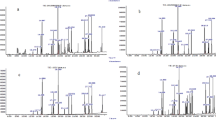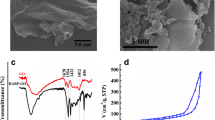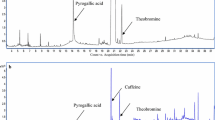Abstract
Graphene is a novel class of carbon nanostructures with ultrahigh specific surface area. Graphene has already been used in many fields and has great promise for use in sorbent materials. In this study, we used graphene mixed with primary secondary amine (PSA) and graphitized carbon black (GCB) as dispersive solid-phase extraction materials for the cleanup of tea for the first time. Compared to the literature, the amount of PSA and GCB was greatly reduced. A multi-residue method combined with liquid chromatography–tandem mass spectrometry was validated for rapid determination of 25 pesticide residues in tea. Green tea, black tea, and white tea were selected as matrixes, representing the majority of tea types. Recoveries ranged from 71.1 to 108.3 % and consistent relative standard deviations <13.6 % for all 25 pesticides. Graphene has significant potential as a promising new adsorbent for pesticide residue analysis of teas. This method can be used to analyze tea samples with different degrees of fermentation.

Similar content being viewed by others
References
Dufresne CJ, Farnworth ER (2001) A review of latest research findings on the health promotion properties of tea. J Nutr Biochem 12:404–421
Karakaya S, Kavas A (1999) Antimutagenic activities of some foods. J Sci Food Agric 79:237–242
Almajanoa MP, Carbó R, López Jiménez JA, Michael HG (2008) Antioxidant and antimicrobial activities of tea infusions. Food Chem 108:55–63
Uchenna JU, Selena A, Adam K, James TL, Edward JK (2010) White and green teas (Camellia sinensis var. sinensis): variation in phenolic, methylxanthine, and antioxidant profiles. J Food Sci 75:6
Chen GQ, Cao PY, Liu RJ (2011) A multi-residue method for fast determination of pesticides in tea by ultra performance liquid chromatography–electrospray tandem mass spectrometry combined with modified QuEChERS sample preparation procedure. Food Chem 125:1406–1411
Schurek J, Portolés T, Hajslova J, Riddellova K, Hernández F (2008) Application of head-space solid-phase microextraction coupled to comprehensive two-dimensional gas chromatography–time-of-flight mass spectrometry for the determination of multiple pesticide residues in tea samples. Anal Chim Acta 611:163–172
Pose-Juan E, Rial-Otero R, Martínez-Carballo E, López-Periago E, Simal-Gándara J (2009) Determination of metalaxyl and identification of adjuvants in wettable powder pesticide technical formulas. Anal Bioanal Chem 394:1535–1544
López-Fernández O, Rial-Otero R, González-Barreiro C, Simal-Gándara J (2012) Surveillance of fungicidal dithiocarbamate residues in fruits and vegetables. Food Chem 134:366–374
Feng J, Tang H, Chen DZ, Dong HF, Li L (2013) Accurate determination of pesticide residues incurred in tea by gas chromatography-high resolution isotope dilution mass spectrometry. Anal Methods 5:4196–4204
Zhao PY, Wang L, Jiang YP, Zhang FZ, Pan CP (2012) Dispersive cleanup of acetonitrile extracts of tea samples by mixed multiwalled carbon nanotubes, primary secondary amine, and graphitized carbon black sorbents. J Agric Food Chem 60:4026–4033
Guan WB, Li ZN, Zhang HY, Hong HJ, Rebeyev N, Ye Y, Ma YQ (2013) Amine modified graphene as reversed-dispersive solid phase extraction materials combined with liquid chromatography–tandem mass spectrometry for pesticide multi-residue analysis in oil crops. J Chromatogr A 1286:1–8
Huang Z, Li Y, Chen B, Yao S (2007) Simultaneous determination of 102 pesticide residues in Chinese teas by gas chromatography–mass spectrometry. J Chromatogr B 853:154–162
Wilkowska A, Biziuk M (2011) Determination of pesticide residues in food matrices using the QuEChERS methodology. Food Chem 125:803–812
Mastovska K, Dorweiler KJ, Lehotay SJ, Wegscheid JS, Szpylka KA (2010) Extension of the QuEChERS method for pesticide residues in cereals to flaxseeds, peanuts, and doughs. J Agric Food Chem 58:5950–5958
Reid AM, Brougham CA, Fogarty AM, Roche JJ (2009) Accelerated solvent-based extraction and enrichment of selected plasticisers and 4-nonylphenol, and extraction of tin from organotin sources in sediments, sludges and leachate soils. Anal Chim Acta 634:197–204
Guan YQ, Tang H, Chen DZ, Xu T, Li L (2013) Modified QuEChERS method for the analysis of 11 pesticide residues in tea by liquid chromatography–tandem mass spectrometry. Anal Methods 5:3056–3067
Rajski Ł, Lozano A, Belmonte-Valles N, Uclés A, Uclés S, Mezcua M, Fernandez-Alba AR (2013) Comparison of three multiresidue methods to analyse pesticides in green tea with liquid and gas chromatography/tandem mass spectrometry. Analyst 138:921–931
Wu XL, Hong HJ, Liu XT, Guan WB, Meng LX, Ye Y, Ma YQ (2013) Graphene-dispersive solid-phase extraction of phthalate acid esters from environmental water. Sci Total Environ 444:224–230
Wu XL, Zhang HY, Meng LX, Liu XT, Ma YQ (2012) Graphene for cleanup in trace analysis of pyrethroid insecticides in cucumber and spinach. Chromatographia 75:1177–1183
Wang YK, Gao ST, Zang XH, Li JC, Ma JJ (2012) Graphene-based solid-phase extraction combined with flame atomic absorption spectrometry for a sensitive determination of trace amounts of lead in environmental water and vegetable samples. Anal Chim Acta 716:112–118
Hummers WS, Offeman RE (1958) Preparation of graphitic oxide. J Am Chem Soc 80:1339
Kolberg DI, Prestes OD, Adaime MB, Zanella R (2011) Development of a fast multiresidue method for the determination of pesticides in dry samples (wheat grains, flour and bran) using QuEChERS based method and GC-MS. Food Chem 125:1436–1442
IUPAC guidance on residue analytical methods. http://agrochemicals.iupac.org/
European Council 2002/657/EC (2002) Implementing council directive 96/23/EC concerning the performance of analytical methods and the interpretation of results
Acknowledgments
This work was supported by National Scientific and Technology Supporting Program of China (2011BAE06B05-5) and the science and technology fund of Beijing Municipal Commission of Education (Project Number KZ201210020019), National Science Foundation of China (31272076).
Author information
Authors and Affiliations
Corresponding author
Rights and permissions
About this article
Cite this article
Liu, X., Guan, W., Hao, X. et al. Pesticide Multi-Residue Analysis in Tea Using d-SPE Sample Cleanup with Graphene Mixed with Primary Secondary Amine and Graphitized Carbon Black Prior to LC–MS/MS. Chromatographia 77, 31–37 (2014). https://doi.org/10.1007/s10337-013-2583-7
Received:
Revised:
Accepted:
Published:
Issue Date:
DOI: https://doi.org/10.1007/s10337-013-2583-7




